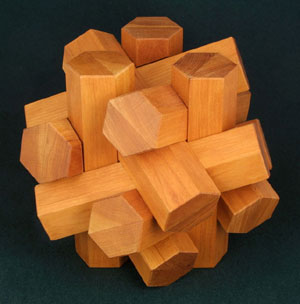
[Home] [Contents] [Figures] [Search] [Help]
[Next Page] [Prev Page] [ Next Chapter] [Prev Chapter]
The basic cluster of 12 triangular sticks shown in Fig. 93, upon which most of the designs in this and the previous five chapters have been built, suggests the possibility of converting them into interlocking notched hexagonal sticks. With two trapezoidal notches in each stick, they form a neat interlocking structure of 12 identical pieces, as shown in Figs. 135a and 135b, but which is impossible to assemble. A third notch in three of the pieces allows the puzzle to be assembled.
Fig. 135a
Fig. 135b
There are three distinctly different solutions to this puzzle, which can be defined by the arrangement of the three-notch pieces. The easiest and most obvious solution is with these three odd pieces going in last in a triangular arrangement to complete the assembly. In the second solution, the three odd pieces are mutually parallel, and there is a key piece that slides in last. The third solution is more difficult. Here is a case where multiple solutions make the puzzle more interesting.
This puzzle is enhanced by using four colors for the pieces, three of each color. If the three odd pieces are the same color, the first two solutions can have different sorts of color symmetry. The second solution is especially interesting, with all like-colored pieces being mutually parallel.
This puzzle was at one time manufactured in plastic as Hectix, but unfortunately never in four colors (saving the manufacturer a penny or two). A few have been produced in wood, which is quite easy with a supply of hexagonal stock and a trapezoidal cutter. Aside from its considerable potential as a very satisfactory assembly puzzle, it would make a handsome sculpture in brass or stainless steel, or perhaps even cast in concrete on a massive scale. (Reference: US Patent 3,721,448 to Coffin, 1973.)
| ©1990-2005 by Stewart T. Coffin For questions or comments regarding this site, contact the chief metagrobologist: |
[Next Page] [Prev Page] [ Next Chapter] [Prev Chapter]